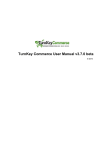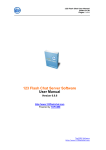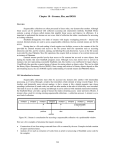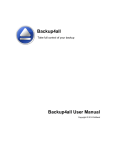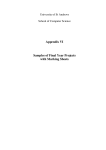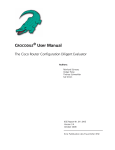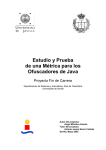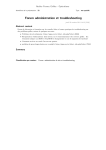Download Obfuscating Classes
Transcript
04 0672326388 CH03
4/9/04
2:34 PM
Page 27
Obfuscating Classes
“Any sufficiently advanced technology is indistinguishable from
magic.”
3
IN THIS CHAPTER
Murphy’s Technology Laws
. Protecting the Ideas
Behind Your Code 27
Protecting the Ideas Behind
Your Code
Reverse engineering and hacking have been around since
the early days of software development. As a matter of fact,
stealing or replicating someone else’s ideas has always been
the easiest way of creating competitive products. There is,
of course, a perfectly acceptable method of building on
previous discoveries by others—and as long as the others
don’t mind, it works fine. Most inventors and researchers,
however, would like to get credit and possibly a financial
reward for their work. In simpler terms, they also have
mortgages to pay and vacations to take.
A good way of protecting intellectual property is for the
author to obtain copyrights and patents on the unique
features of the work. This is certainly recommended for
inventions and major discoveries that required a lot of
investment into research and development. Copyrighting
software is a rather easy and cost-effective process, but it
protects only the “original” code of the application, not
the ideas behind it. Others would not be able to take copyrighted code and use it in their applications without the
author’s permission, but if they have their own implementation of the same feature, it would not be considered a
violation to use that. Patents provide a much better protection because they cover the ideas and algorithms rather
than a specific implementation, but they are expensive to
file and can take years to obtain.
. Obfuscation As a
Protection of
Intellectual Property
28
. Transformations Performed
by Obfuscators 29
. Knowing the Best
Obfuscators 33
. Potential Problems and
Common Solutions 34
. Using Zelix KlassMaster to
Obfuscate a Chat
Application 36
. Cracking Obfuscated Code
40
. Quick Quiz
. In Brief
41
41
04 0672326388 CH03
28
CHAPTER 3
4/9/04
2:34 PM
Page 28
Obfuscating Classes
Is the risk of having your application hacked real? If it has good ideas, then absolutely. Most
of the widely publicized reverse engineering cases at the time of this writing did not occur
with Java products, but here’s an excerpt from a Java vendor (DataDirect Technologies):
ROCKVILLE, MD., July 1, 2002—DataDirect Technologies, Inc., an industry-leading data connectivity
vendor has filed a lawsuit against i-net Software GmbH alleging copyright infringement and breach of
contract. DataDirect Technologies is seeking both preliminary and permanent injunctive relief to prevent
i-net from engaging in further efforts to market and sell products which DataDirect Technologies
believes were illegally reverse-engineered from its products.
DataDirect Technologies claims that a competitor reverse engineered its product, and yet
even today its product has only minimal protection from decompiling.
In the real world, copyrighting the code and getting a patent for an approach cannot provide
adequate protection if a competitor or hacker can easily learn the implementation from the
source code. The issues of legal protection are discussed in a separate chapter, but for now,
let’s focus on smart ways to protect the intellectual property (IP) of Java applications.
Obfuscation As a Protection of
Intellectual Property
Obfuscation is the process of transforming bytecode to a less human-readable form with the
purpose of complicating reverse engineering. It typically includes stripping out all the debug
information, such as variable tables and line numbers, and renaming packages, classes, and
methods to machine-generated names. Advanced obfuscators go further and change the
control flow of Java code by restructuring the existing logic and inserting bogus code that
will not execute. The premise of the obfuscation is that the transformations do not break the
validity of the bytecode and do not alter the exposed functionality.
Obfuscation is possible for the same reasons that decompiling is possible: Java bytecode is
standardized and well documented. Obfuscators load Java class files, parse their formats, and
then apply transformations based on supported features. When all the transformations are
applied, the bytecode is saved as a new class file. The new file has a different internal structure but behaves just like the original file.
Obfuscators are especially necessary for products and technologies in which the implementation logic is delivered to the user. That is the case for HTML pages and JavaScript where the
product is distributed in source code form. Java doesn’t fare much better because, even
though it is typically distributed in binary bytecode, using a decompiler as described in the
previous chapter can produce the source code—which is almost as good as the original.
04 0672326388 CH03
4/9/04
2:34 PM
Page 29
29
Transformations Performed by Obfuscators
Transformations Performed by Obfuscators
No standards exist for obfuscation, so the level of protection varies based on the quality of
the obfuscator. The following sections present some of the features commonly found in
obfuscators. We will use ChatServer’s sendMessage method to illustrate how each transformation affects the decompiled code. The original source code for sendMessage is shown in
Listing 3.1.
LISTING 3.1
Original Source Code of sendMessage
public void sendMessage(String host, String message) throws Exception {
if (host == null || host.trim().length() == 0)
throw new Exception (“Please specify host name”);
System.out.println(“Sending message to host “ + host + “: “ + message);
String url = “//” + host + “:” + this.registryPort + “/chatserver”;
ChatServerRemote remoteServer = (ChatServerRemote)Naming.lookup(url);
MessageInfo messageInfo = new MessageInfo(this.hostName, this.userName);
remoteServer.receiveMessage(message, messageInfo);
System.out.println(“Message sent to host “ + host);
}
Stripping Out Debug Information
Java bytecode can contain information inserted by the compiler that helps debug the
running code. The information inserted by javac can contain some or all of the following:
line numbers, variable names, and source filenames. Debug information is not needed to run
the class but is used by debuggers to associate the bytecode with the source code.
Decompilers use this information to better reconstruct the source code. With full debug information in the class file, the decompiled code is almost identical to the original source code.
When the debug information is stripped out, the names that were stored are lost, so decompilers have to generate their own names. In our case, after the stripping, sendMessage parameter names would appear as s1 and s2 instead of host and message.
Name Mangling
Developers use meaningful names for packages, classes, and methods. Our sample chat application’s server implementation is called ChatServer and the method that sends a message to
another user is called sendMessage. Good names are crucial for development and maintenance, but they mean nothing to the JVM. Java Runtime (JRE) doesn’t care whether
sendMessage is called goShopping or abcdefg; it still invokes it and executes it. By renaming
04 0672326388 CH03
30
CHAPTER 3
4/9/04
2:34 PM
Page 30
Obfuscating Classes
the meaningful human-readable names to meaningless machine-generated ones, obfuscators
make the task of understanding the decompiled code much harder. What used to be
ChatServer.sendMessage becomes d.a; when many classes and methods exist with the same
names, the decompiled code is extremely hard to follow. A good obfuscator takes advantage
of polymorphism to make matters worse. Three methods with different names and signatures
doing different tasks in the original code can be renamed to the same common name in the
obfuscated code. Because their signatures are different, it does not violate the Java language
specification but adds confusion to the decompiled code. Listing 3.2 shows an example of a
decompiled sendMessage after obfuscation that stripped the debugging information and
performed name mangling.
LISTING 3.2
Decompiled sendMessage After Name Mangling
public void a(String s, String s1)
throws Exception
{
if(s == null || s.trim().length() == 0)
{
throw new Exception(“Please specify host name”);
} else
{
System.out.println(String.valueOf(String.valueOf((
new StringBuffer(“Sending message to host “)
).append(s).append(“: “).append(s1))));
String s2 = String.valueOf(String.valueOf((
new StringBuffer(“//”)).append(s).append(“:”)
.append(b).append(“/chatserver”)));
b b1 = (b)Naming.lookup(s2);
MessageInfo messageinfo = new MessageInfo(e, f);
b1.receiveMessage(s1, messageinfo);
System.out.println(“Message sent to host “.concat(
String.valueOf(String.valueOf(s))));
return;
}
}
Encoding Java Strings
Java strings are stored as plain text inside the bytecode. Most of the well-written applications
have traces inside the code that produce execution logs for debugging and audit trace. Even if
class and method names are changed, the strings written by methods to a log file or console
04 0672326388 CH03
4/9/04
2:34 PM
Page 31
31
Transformations Performed by Obfuscators
can betray the method purpose. In our case, ChatServer.sendMessage outputs a trace
message using the following:
System.out.println(“Sending message to host “ + host + “: “ + message);
Even if ChatServer.sendMessage is renamed to d.a, when you see a trace like this one in the
decompiled message body, it is clear what the method does. However, if the string is encoded
in bytecode, the decompiled version of the class looks like this:
System.out.println(String.valueOf(String.valueOf((new
StringBuffer(a(“A\025wV6|\0279_:a\003xU:2\004v\0227}\003m\022”))
).append(s).append(a(“(P”)).append(s1))));
If you look closely at the encoded string, it is first passed to the a() method, which decodes
it and returns the readable string to the System.out.println() method. String encoding is a
powerful feature that should be provided by a commercial-strength obfuscator.
Changing Control Flow
The transformations presented earlier make reverse engineering of the obfuscated code
harder, but they do not change the fundamental structure of the Java code. They also do
nothing to protect the algorithms and program control flow, which is usually the most
important part of the innovation. The decompiled version of ChatServer.sendMessage
shown earlier is still fairly understandable. You can see that the code first checks for valid
input and throws an exception upon error. Then it looks up the remote server object and
invokes a method on it.
The best obfuscators are capable of transforming the execution flow of bytecode by inserting
bogus conditional and goto statements. This can slow down the execution somewhat, but it
might be a small price to pay for the increased protection of the IP. Listing 3.3 shows what
sendMessage has become after all the transformations discussed earlier have been applied.
LISTING 3.3
Decompiled sendMessage After All Transformations
public void a(String s, String s1)
throws Exception
{
boolean flag = MessageInfo.c;
s;
if(flag) goto _L2; else goto _L1
_L1:
JVM INSTR ifnull 29;
goto _L3 _L4
_L3:
s.trim();
04 0672326388 CH03
32
CHAPTER 3
4/9/04
2:34 PM
Page 32
Obfuscating Classes
LISTING 3.3
Continued
_L2:
if(flag) goto _L6; else goto _L5
_L5:
length();
JVM INSTR ifne 42;
goto _L4 _L7
_L4:
throw new Exception(a(“\002)qUe7egDs1,rM6:*g@6<$yQ”));
_L7:
System.out.println(String.valueOf(String.valueOf((
new StringBuffer(a(“\001 zP\177<\”4Ys!6uSsr1{\024~=6`\024”))
).append(s).append(a(“he”)).append(s1))));
String.valueOf(String.valueOf(
(new StringBuffer(a(“}j”))).append(s).append(“:”)
.append(b).append(a(“}&|Ub! fBs “))));
_L6:
String s2;
s2;
covertjava.chat.b b1 = (covertjava.chat.b)Naming.lookup(s2);
MessageInfo messageinfo = new MessageInfo(e, f);
b1.receiveMessage(s1, messageinfo);
System.out.println(a(“\037 gGw5 4Gs<14@yr-{Gbr”).concat(String.valueOf
➥(String.valueOf(s))));
if(flag)
b.c = !b.c;
return;
}
Now that’s a total, but powerful, mess! sendMessage is a fairly small method with little conditional logic. If control flow obfuscation was applied to a more complex method with for
loops, if statements, and local variables, the obfuscation would be even more effective.
Inserting Corrupt Code
Inserting corrupt code is a somewhat dubious technique used by some obfuscators to prevent
obfuscated classes from decompiling. The technique is based on a loose interpretation of the
Java bytecode specification by the Java Runtime. JRE does not strictly enforce all the rules of
bytecode format verification, and that allows obfuscators to introduce incorrect bytecode into
the class files. The introduced code does not prevent the original code from executing, but an
attempt to decompile the class file results in a failure—or at best in confusing source code full
of JVM INSTR keywords. Listing 3.3 shows how a decompiler might handle corrupt code. The
risk of using this method is that the corrupted code might not run on a version of JVM that
04 0672326388 CH03
4/9/04
2:34 PM
Page 33
33
Knowing the Best Obfuscators
more closely adheres to the specification. Even if it is not an issue with the majority of JVMs
today, it might become a problem later.
Eliminating Unused Code (Shrinking)
As an added benefit, most obfuscators remove unused code, which results in application size
reduction. For example, if a class called A has a method called m() that is never called by any
class, the code for m() is stripped out of A’s bytecode. This feature is especially useful for code
that is downloaded via the Internet or installed in unsecured environments.
Optimizing Bytecode
Another added benefit touted by obfuscators is potential code optimization. The vendors
claim that declaring nonfinal methods as final where possible and performing minor code
improvements can help speed up execution. It is hard to assess the real performance gains,
and most vendors do not publish the metrics. What is worth noting here is that, with every
new release, JIT compilers are becoming more powerful. Therefore, features such as method
finalization and dead code elimination are most likely performed by it anyway.
Knowing the Best Obfuscators
Plenty of obfuscators are available, and most of them contain the same set of core features.
Table 3.1 includes just a few of the most popular products, both free and commercial.
TA B L E 3 . 1
Popular Obfuscators
PRODUCT
KLASSMASTER
PROGUARD RETRO GUARD DASH-O
JSHRINK
Version
Price
4.1
1.7
1.1.13
2.x
2.0
$199–$399
Free
Free
$895–$2995 $95
Stripping out of debug
information
Yes
Yes
Yes
Yes
Yes
Name mangling
Yes
Yes
Yes
Yes
Yes
Encoding of Java strings
Yes
No
No
No
Yes
Changing of control flow
Yes
No
No
No
No
Insertion of corrupt code
Yes
No
No
No
No
Elimination of unused
code (shrinking)
Yes
Yes
No
Yes
Yes
Optimizing of bytecode
No
No
No
Yes
Yes
Flexibility of scripting
language and obfuscation
control
Excellent
Excellent
Good
Not rated
Good
Reconstruction of
stack traces
Yes
Yes
No
No
No
04 0672326388 CH03
34
CHAPTER 3
4/9/04
2:34 PM
Page 34
Obfuscating Classes
For commercial applications that contain intellectual property, I recommend Zelix
KlassMaster primarily because of its unique control flow obfuscation. This technique makes
the obfuscated code truly hard to crack, so the product is worth every dollar you will pay for
it. At the time of writing, it is the only obfuscator known to have this feature. ProGuard is
available free from www.sourceforge.net and is the best choice for the budget-conscious user
with applications that do not require commercial-strength protection.
Potential Problems and Common Solutions
Obfuscation is a reasonably safe process that should preserve application functionality.
However, in certain cases the transformations performed by obfuscators can inadvertently
break code that used to work. The following sections look at the common problems and
recommended solutions.
Dynamic Class Loading
The renaming of packages, classes, methods, and variables works fine as long as the name is
changed consistently throughout the system. Obfuscators ensure that any static references
within the bytecode are updated to reflect the new name. However, if the code performs
dynamic class loading using Class.forName() or ClassLoader.loadClass() passing an original class name, a ClassNotFound exception can result. Modern obfuscators are pretty good
with handling such cases, and they attempt to change the strings to reflect the new names. If
the string is created at runtime or read from a properties file, though, the obfuscator is incapable of handling it. Good obfuscators produce a log file with warnings pointing out the
code that has potential for runtime problems.
STORIES FROM THE TRENCHES
The most innovative product from CreamTec is WebCream, which is available for a free download
from the Web. The free edition is limited to five concurrent users; to get more users, you must buy
a commercial license. Having grown up in the Ukraine, I knew many people who would prefer to
crack the licensing to turn the free edition into an unlimited edition that would normally be worth
thousands of dollars. At CreamTec, we used a simple, free obfuscator that didn’t do much more
than name mangling. We thought it was good enough until a friend of mine, who views limitedfunctionality commercial software as a personal insult, cracked our licensing code in less than 15
minutes. The message was clear enough, and we decided to purchase Zelix KlassMaster to protect
the product as well as we could. After we used the aggressive control flow obfuscation with a few
extra tricks, our friend has not been able to get to the licensing code with the same ease as
before—and because he didn’t want to spend days figuring it out, he has given up.
04 0672326388 CH03
4/9/04
2:34 PM
Page 35
35
Potential Problems and Common Solutions
The simplest solution is to configure the obfuscator to preserve the names of dynamically
loaded classes. The content of the class, such as the methods, variables, and code, can still be
transformed.
Reflection
Reflection requires compile-time knowledge of method and field names, so it is also affected
by obfuscation. Be sure to use a good obfuscator and to review the log file for warnings. Just
as with the dynamic class loading, if runtime errors are caused by obfuscation, you must
exclude from obfuscation the method or field names that are referenced in Class.getMethod
or Class.getField.
Serialization
Serialized Java objects include instance data and information about the class. If the version of
the class or its structure changes, a deserialization exception can result. Obfuscated classes
can be serialized and deserialized, but an attempt to deserialize an instance of a nonobfuscated class by an obfuscated class will fail. This is not a very common problem, and it can
usually be solved by excluding the serializable classes from obfuscation or avoiding the
mixing of serialized classes.
Naming Conventions Violation
The renaming of methods can violate design patterns such as Enterprise JavaBeans (EJB),
where the bean developer is required to provide methods with certain names and signatures.
EJB callback methods such as ejbCreate and ejbRemove are not defined by a super class or an
interface. Providing these methods with a specific signature is a mere convention prescribed
by EJB specification and enforced by the container. Changing callback method names violates
the naming convention and makes the bean unusable. You should always be sure to exclude
the names of such methods from obfuscation.
Maintenance Difficulties
Last, but not least, obfuscation makes maintaining and troubleshooting applications more
difficult. Java exception handling is an effective way of isolating the faulty code, and looking
at the stack trace can generally give you a good idea of what went wrong and where. Keeping
the debugging information for source filenames and line numbers enables the runtime to
report the exact location in code where the error occurred. If done carelessly, obfuscation can
inhibit this feature and make debugging harder because the developer sees only the obfuscated class names instead of the real class names and line numbers.
04 0672326388 CH03
36
CHAPTER 3
4/9/04
2:34 PM
Page 36
Obfuscating Classes
You should preserve at least the line number information in the obfuscated code. Good
obfuscators produce a log of the transformations, including the mapping between the original class names and methods and the obfuscated counterparts. The following is an excerpt
from the log file generated by Zelix KlassMaster for the ChatServer class:
Class: public covertjava.chat.ChatServer
=>
covertjava.chat.d
Source: “ChatServer.java”
FieldsOf: covertjava.chat.ChatServer
hostName
=>
e
protected static instance
=>
a
messageListener
=>
d
protected registry
=>
c
protected registryPort
=>
b
userName
=>
f
MethodsOf: covertjava.chat.ChatServer
public static getInstance()
=>
a
public getRegistry(int)
=>
a
public init()
=>
b
public receiveMessage(java.lang.String, covertjava.chat.MessageInfo)
➥NameNotChanged
public sendMessage(java.lang.String, java.lang.String)
=>
a
public setMessageListener(covertjava.chat.MessageListener)
=>
a
So, if an exception stack trace shows the covertjava.chat.d.b method, you can use the
log and find out that it was originally called “init” in a class that was originally called
covertjava.chat.ChatServer. If the exception occurred in covertjava.chat.d.a, you would
not know the original method name for sure because multiple mappings exist (witness the
power of overloading). That’s why line numbers are so important. By using the log file and
the line number in the original source file, you can quickly locate the problem area in the
application code.
Some obfuscators provide a utility that reconstructs the stack traces. This is a convenient way
of getting the real stack trace for the obfuscated stack trace. The utility typically uses the
same method as we used earlier, but it automates the job—so why not save ourselves some
time? It also allows scrambling the line numbers for extra protection.
Using Zelix KlassMaster to Obfuscate
a Chat Application
Even though each obfuscator has its own format of configuring the transformations, they all
support a common set of features. The Chat application does not contain state-of-the-art
algorithms or patent-pending inventions, but it is dear to our hearts so we are going to use
Zelix KlassMaster to protect it from the prying eyes of hackers and thieves.
04 0672326388 CH03
4/9/04
2:34 PM
Page 37
37
Using Zelix KlassMaster to Obfuscate a Chat Application
First, we obtain a copy of Zelix KlassMaster and install it on a local machine. Remember that
we refer to the Chat application’s home directory as CovertJava. Next, we copy ZKM.jar from
KlassMaster’s installation directory to our project lib directory so we can script against it. The
easiest way to create the obfuscation script is with KlassMaster’s GUI. Using the command
java -jar ZKM.jar
from the lib directory, we run the GUI. Then, in the initial helper dialog box that appears,
we select the Set Classpath option. We now select the runtime libraries of the JDK we’re using
and, in the Open Classes dialog box that appears next, we select CovertJava/lib/chat.jar.
After that, KlassMaster should load all the classes of the Chat application and we should
be able to view the internal structure of the bytecode. The screen should look similar to
Figure 3.1.
FIGURE 3.1
Chat classes loaded into the KlassMaster GUI.
While working with the GUI, you can easily see just how flexible KlassMaster is. You can
manually change the names of classes, methods, and fields; modify the visibility of classes or
methods; make methods final; change text strings; and do other cool stuff. KlassMaster
attempts to propagate the changes throughout the loaded code, so if other classes refer to a
method and you change its name, the referring classes are updated to reflect the change.
After making all your changes, you can save the classes as is or trim and obfuscate them first.
Classes loaded into the GUI environment can be further modified after the obfuscation, even
though I can’t think of a reason why someone would need to do so. For details of
KlassMaster’s features and how to use it, please refer to its user manual.
04 0672326388 CH03
38
CHAPTER 3
4/9/04
2:34 PM
Page 38
Obfuscating Classes
A well-written Java application provides scripts to build it, so let’s integrate obfuscation into
our build script. We start by using KlassMaster’s GUI to create the obfuscation script. Then,
we update it manually to make it more flexible. It is entirely possible to write the script
manually or copy and modify a sample script. We run the GUI and select ZKM Script Helper
from the Tools menu. Then, we do the following:
1. Read the instructions on the Introductory Page and click Next.
2. On the Classpath Statement page, select rt.jar and click Next.
3. On the Open Statement page, navigate to CovertJava/distrib/chat.jar and click > to
select it for opening. We only need one file because all our application classes are packaged in it. Click Next.
4. On the TrimExclude Statement page, the default exclusions are preset to exclude the
cases where obfuscation is likely to result in an error. For example, renaming methods
of an EJB implementation class makes it unusable, so EJBs are excluded by default.
5. On the Trim Statement page, select the Delete Source File Attributes check box and the
Delete Deprecated Attributes check box to get rid of the debug information; then click
Next.
6. In the Don’t Change Main Class Name combo box on the Exclude Statement page,
select covertjava.chat.ChatApplication to preserve its name. This keeps JAR manifest
entries valid and enables users to continue invoking the chat using a human-readable
name.
7. On the Obfuscate Statement page, select Aggressive in the Obfuscate Control Flow
combo box. Then select Aggressive in the Encrypt String Literals combo box, and select
Scramble in the Line Number Tables combo box. This ensures adequate protection for
the code but enables us to translate stack traces later. Make sure that Produce a Change
Log File is checked and click Next.
8. On the SaveAll Statement page, navigate to CovertJava/distrib and create a subdirectory called obfuscated. Select the newly created directory for output and click Next.
9. The next page should show the script text and allow us to save it to a directory. Save it
as obfuscate_script.txt in the CovertJava/build directory and exit the GUI.
The resulting script should look similar to Listing 3.4.
LISTING 3.4
Obfuscation Script Generated by the GUI
/******************************************************************************/
/* Generated by Zelix KlassMaster 4.1.1 ZKM Script Helper 2003.08.13 17:03:43 */
/******************************************************************************/
04 0672326388 CH03
4/9/04
2:34 PM
Page 39
39
Using Zelix KlassMaster to Obfuscate a Chat Application
classpath
“c:\java\jdk1.4\jre\lib\rt.jar”
“c:\java\jdk1.4\jre\lib\sunrsasign.jar”
“c:\java\jdk1.4\jre\lib\jsse.jar”
“c:\java\jdk1.4\jre\lib\jce.jar”
“c:\java\jdk1.4\jre\lib\charsets.jar”;
open
“C:\Projects\CovertJava\distrib\chat.jar”;
trim
deleteSourceFileAttributes=true
deleteDeprecatedAttributes=true
deleteUnknownAttributes=false;
exclude
covertjava.chat.^ChatApplication^ public static main(java.lang.String[]);
obfuscate
changeLogFileIn=””
changeLogFileOut=”ChangeLog.txt”
obfuscateFlow=aggressive
encryptStringLiterals=aggressive
lineNumbers=scramble;
saveAll
archiveCompression=all “C:\Projects\CovertJava\distrib\obfuscated”;
A good idea would be to replace the absolute file paths with the relative ones, so that instead
of opening C:\Projects\CovertJava\distrib\chat.jar, the script opens distrib\chat.jar.
Finally, we will integrate obfuscation into the build process by declaring a custom task and
adding a target that calls it. KlassMaster is written in Java and can be called from any build
script. Conveniently, it provides a wrapper class for Ant integration, so all we have to do is
add the following to Chat’s build.xml:
<!-- Define a task that will execute Zelix KlassMaster to obfuscate classes -->
<taskdef name=”obfuscate” classname=”ZKMTask” classpath=”${basedir}/lib/ZKM.jar”/>
...
<!-- Define a target that produces obfuscated version of Chat -->
<target name=”obfuscate” depends=”release”>
<obfuscate scriptFileName=”${basedir}/build/obfuscate_script.txt”
logFileName=”${basedir}/build/obfuscate_log.txt”
trimLogFileName=”${basedir}/build/obfuscate_trim_log.txt”
defaultExcludeFileName=”${basedir}/build/obfuscate_defaultExclude.txt”
defaultTrimExcludeFileName=”${basedir}/build/obfuscate_defaultTrimExclude.txt”
defaultDirectoryName=”${basedir}”
/>
</target>
04 0672326388 CH03
40
CHAPTER 3
4/9/04
2:34 PM
Page 40
Obfuscating Classes
We can now run Ant on obfuscate target. If the build is successful, a new file (chat.jar) is
created in CovertJava/distrib/obfuscated. This file contains the obfuscated version of Chat
that can still be invoked using the java -jar chat.jar command. Take a few moments to
look inside that JAR and try decompiling some of the classes.
Before we close the subject of using KlassMaster, I’d like to give a few more examples of script
file syntax for excluding classes and class members from obfuscation. The format shown in
Table 3.2 can be used for statements of obfuscation script that take in names as parameters.
ZKM script language supports wildcards, such as * (any sequence of characters) and ? (any
one character), and boolean operations, such as || (or) and ! (not). For a detailed explanation and full syntax, please refer to KlassMaster documentation.
TA B L E 3 . 2
Commonly Used Name Patterns for KlassMaster
SYNTAX
WHAT IT MATCHES
package1.package2.
Package names package1 and package2. Other package names and
children of package2 are not matched.
*.
All package names in the application.
Class1
The name of the class Class1.
package1.Class1
The name of Class1 in package package1 but not package1’s name.
package1.^Class1
The names of Class1 and package1.
package1.^Class1^ method1()
The names of package1, Class1, and method1 with no parameters.
package1.^Class1^ method1(*)
The names of package1, Class1, and all overloaded versions of method1.
Cracking Obfuscated Code
Now that we have spent so much time talking about how to protect intellectual property
through obfuscation, a few words are due on the strength of the protection. Does a good
obfuscator make it hard to hack an application? Absolutely. Does it guarantee that the application will not be hacked? Not at all!
Unless flow control obfuscation is used, reading and working with the obfuscated code is not
that difficult. The key point is finding a good starting point for decompiling. Chapter 2,
“Decompiling Classes,” presented several techniques for reverse engineering of applications,
but obfuscation can defeat many of them. For example, the most effective way of locating a
starting point is text searching through the class files. With string encoding, the search will
yield no results because the strings are not stored as plain text. Package names and class
names can no longer be used to learn about the application structure and to select a good
starting point. It is still technically possible to decompile the application entry point and
work your way through the control flow for a decent-size application, but it is not feasible.
04 0672326388 CH03
4/9/04
2:34 PM
Page 41
41
In Brief
For flow-obfuscated code, the most sensible method of learning the application implementation is using a good old debugger. Most IDEs come with debugging capabilities, but our case
will require a heavyweight debugger capable of working without the source code. To find a
good starting point for decompiling, the application needs to be run in debug mode. Java has
a standard API for debuggers called Debugger API (duh!) that is capable of local as well as
remote debugging. Remote debugging enables the debugger to attach itself to an application
running in debug mode and is a preferred way of cracking the application. Good debuggers
display in-depth information about running threads, call stacks for each thread, loaded
classes, and objects in memory. They enable you to set a breakpoint and trace the method
executions. A key for working with obfuscated applications is to use the regular interface (UI
or programming API) to navigate to a feature of interest and then to rely on the debugger to
learn about the class or classes that implement the feature. After the classes are identified,
they can be decompiled and studied as described in Chapter 2. Working with debuggers is
covered in detail in Chapter 9, “Cracking Code with Unorthodox Debuggers.”
Quick Quiz
1. What are the means of protecting intellectual property in Java applications?
2. Which transformations provided by obfuscators offer the strongest protection?
3. For each of the potential problems listed in this chapter, which transformation(s) can
cause it?
4. What is the most efficient way to study the obfuscated code?
In Brief
n Obfuscation can be the best way to protect the intellectual property in Java bytecode.
n Obfuscators perform some or all of the following transformations: stripping out debug
information, name mangling, encoding strings, changing control flow, inserting corrupt
code, eliminating unused code, and optimizing bytecode.
n Obfuscation introduces maintenance difficulties that can be minimized by configuring
the obfuscator.
n Obfuscated code is still readable unless control flow obfuscation and string encoding is
used.















